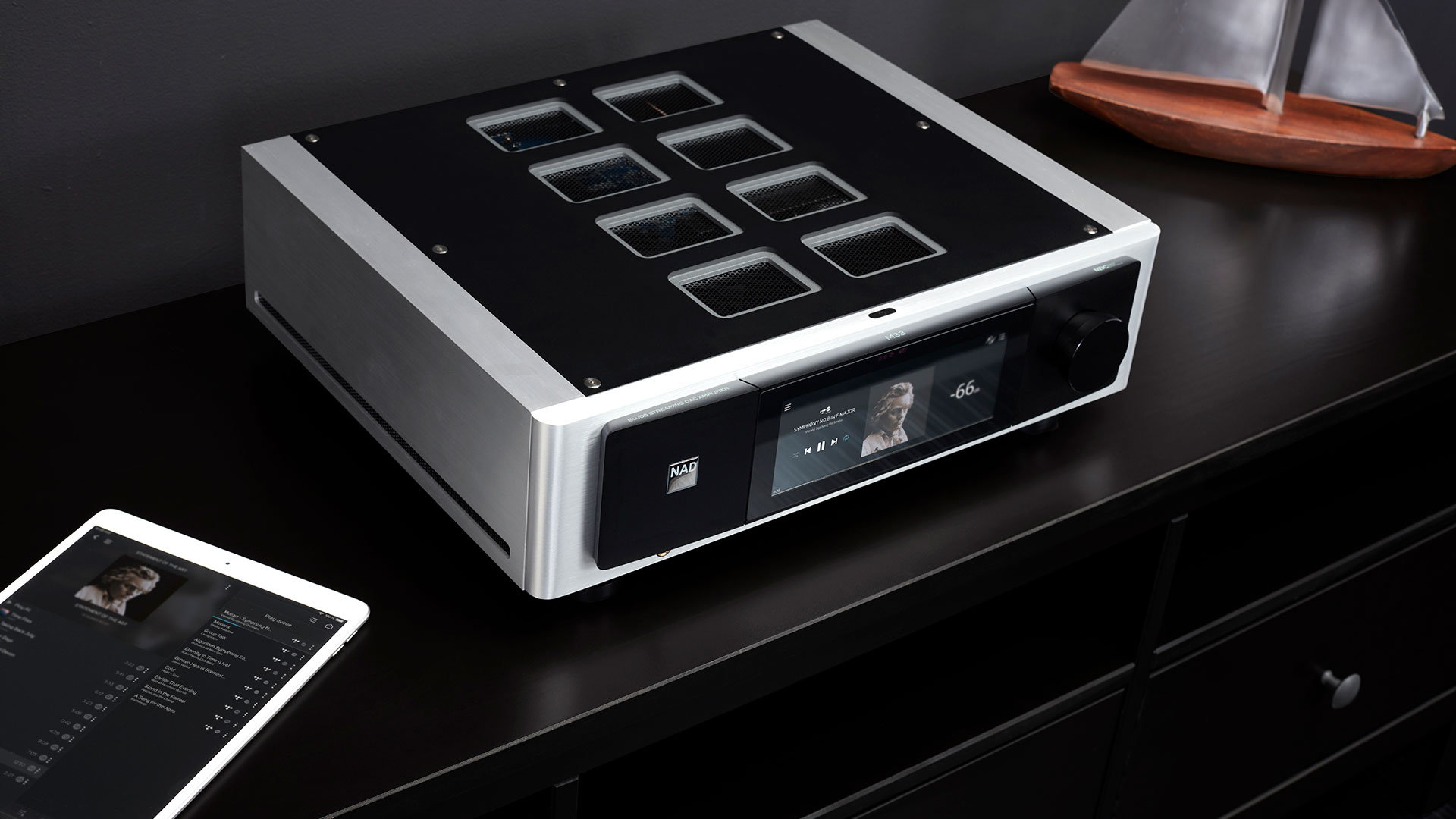Sound+Image Verdict
NAD has successfully combined a high level of amplification with the streaming simplicity of the BluOS platform. The result is beautiful music, made easy.
Pros
- +
Strong sonic performance
- +
Easy internet & network streaming
- +
Dirac Live room correction
Cons
- -
No USB-B for computer playback
- -
Phono input is digitally sampled
- -
Some USB drive playback issues
Why you can trust What Hi-Fi?
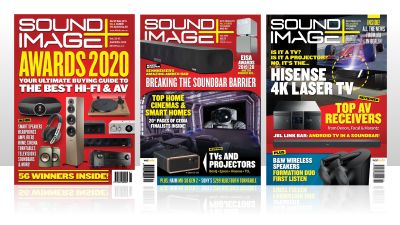
This review originally appeared in Sound+Image magazine, one of What Hi-Fi?’s Australian sister publications. Click here for more information on Sound+Image, including digital editions and details on how you can subscribe.
NAD is a company that made its name in solid and relatively affordable hi-fi separates — the classic CD, amp and speakers ‘student’ system. Yet it has also been at the forefront of two of hi-fi’s most transformative technologies in the last decade: streaming, and ‘digital’ (or switching) amplification.
The main streaming technology adopted by NAD was developed by its parent company, Canada’s Lenbrook, first as Bluesound and then as the BluOS wireless multi-room platform, which NAD has since incorporated into a number of highly successful smart amplifiers, most notably the multi-award-winning NAD M10, with its large visual display and excellent amplification.
The M10 was (and still is) part of NAD’s Masters Series, which began a little over a decade ago to showcase the company’s other innovation, which was to bring new ‘digital’ amplification concepts successfully into hi-fi amplifiers above the level usually occupied by NAD.
At the time, such amplification was regarded suspiciously by most hi-fi fans and companies, but NAD was quick to see its potential, working closely with particular companies and technologies — first a British semiconductor company called Zetex on the technology which became known as Direct Digital, and then with Dutch company Hypex, using its Universal Class D (UcD) and Ncore amplification in what NAD called HybridDigital.
Many other companies have since adopted and adapted Hypex’s modules to take this ‘digital’ amplification to even higher levels of audiophilia. But now NAD has found a new partner, Denmark’s Purifi Audio (which includes Bruno Putzeys of Hypex), and has adopted its Eigentakt amplification technology in order to deliver an amplifier that goes further still - the Masters M33.
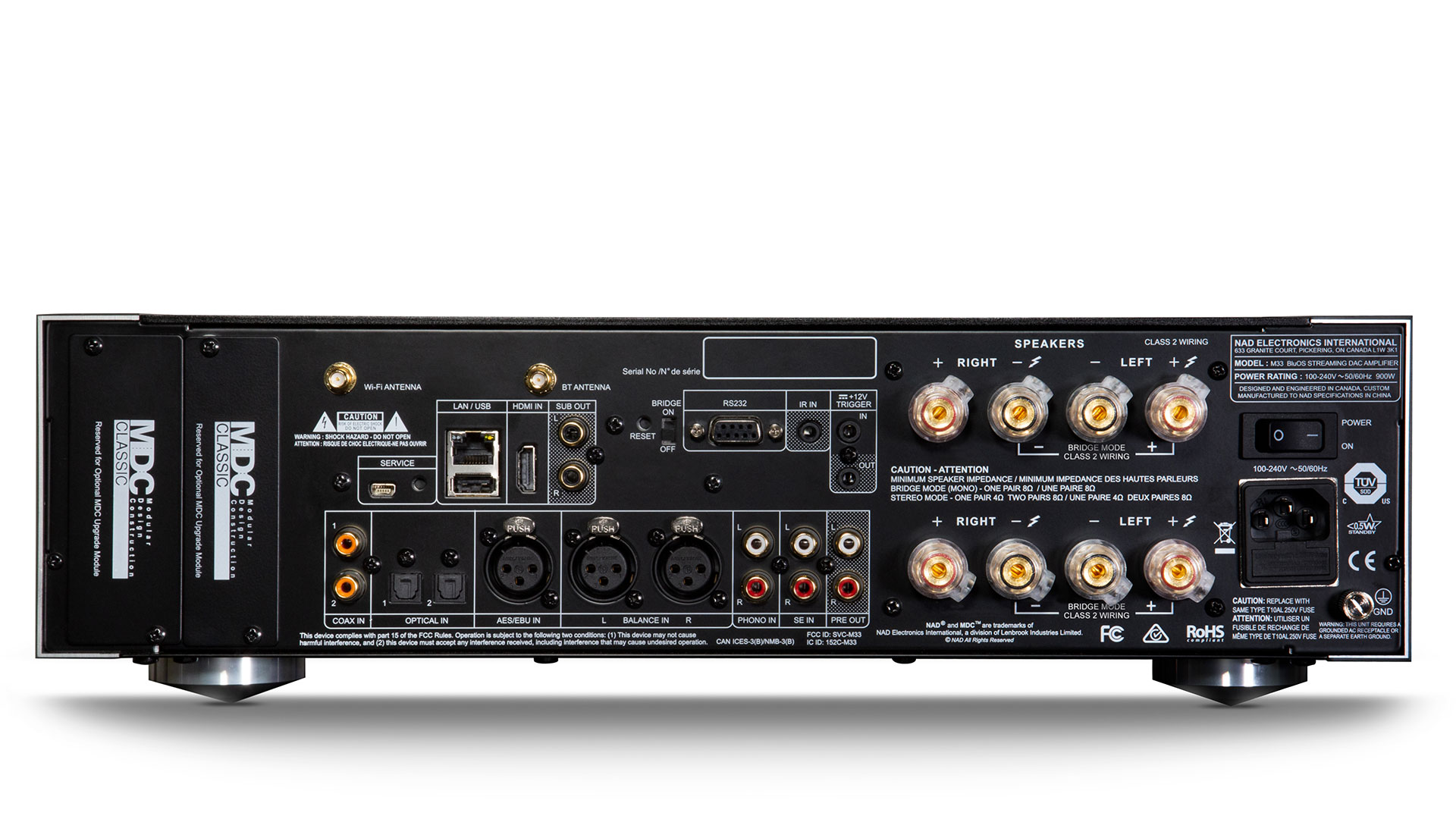
Build & connections
Before delving into the new HybridDigital Purifi Eigentakt amplification within, however, let’s see what NAD has built around it. The Masters Series M33, which NAD describes in rather a mouthful as a ‘BluOS Streaming DAC Integrated Amplifier’, takes the successful equation of the M10 and enlarges it from a half-width to a full-width product, fronted again by a large colour touchscreen, but here also offering a nice volume knob to the right.
Facilities are significantly improved — an excellent headphone output, and far more numerous digital inputs, seven in all — HDMI (with the latest eARC, no less), one AES/EBU, two optical and two coaxial digital inputs, plus a USB-A slot. The only obvious omission is the lack of a USB-B connection for playing direct from computer.
The latest hi-fi, home cinema and tech news, reviews, buying advice and deals, direct to your inbox.
There are three analogue inputs — one line-level RCA, one balanced XLR pair, and yes, a phono input for a turntable, selectable for moving-magnet or moving-coil cartridges, and promising to “rival specialized outboard units” with its super-accurate RIAA equalization and clever phase-cancelling infrasonic filter.
There are two independent subwoofer outputs, twin speaker outputs capable of bi-wiring connections, 12V and IR triggers, RS232 for control, plus Ethernet and Wi-Fi for networking.
A Bluetooth antenna socket supports the Bluetooth spec which includes aptX HD (but does not specify AAC for iOS device owners), and can send as well as receive, so you can listen to the M33 on Bluetooth wireless headphones.
BluOS streaming
Once networked, the M33 gains all the abilities of the BluOS platform (aka Bluesound), becoming capable of streaming from all the key music services including internet radio and a good many offering high-res music (usually for a significant premium subscription) such as Tidal, Deezer and others not yet serving Australia, such as Qobuz and Amazon HD. There’s also compatibility with both Google Assistant and Alexa, and with Siri too, if you’re utilising the M33’s AirPlay 2 abilities to stream from an Apple device.
NAD says that considerable effort has also been spent to make the M33 fully compatible with all the leading smart home systems, including Apple, Crestron, Control4, Lutron, KNX and many others.
As a final long-term bonus there are two empty ‘MDC’ slots to the rear, ready to make use of future modules from NAD. This ‘Modular Design Construction’ has been a feature of higher-level NAD amps for a decade now, allowing owners to tailor additional abilities to their needs, and in future to slot in a card offering newly developed standards or connections. The MDC system thereby makes the M33 about as futureproof as one could reasonably ask.
Setting up
This is one substantial amplifier physically; not only in terms of its size and weight but also its build quality, which separates it (substantially) from the M10, loaded as it is with aluminium blocks slitted for ventilation above the sides, and with eight further grilles through the top-plate doubling ventilation with a tantalising glimpse to the internals. Indeed given that much of this glorious construction is hidden once the M33 is inserted into a conventional hi-fi rack, you may wish to find a way to display it more prominently in your room!
The front fascia has a black anodised protruding frontage housing the power button, display and knob, with a small power button on top (there’s a main power rocker switch to the rear), while the headphone socket lurks underneath, cut through the main aluminium block.
The amplifier space in our reference rack is served with Ethernet, so we quickly had the M33 networked and set up, a Thorens turntable plugged into the back along with SPDIF optical from our computer (converted from USB-B by our resident DAC).
We opened the BluOS app on our iPad Pro to find the M33 available and ready for set-up; its attempt at a firmware update failed, so we followed the on-line manual’s instruction to do a factory reset — but still no update. However, since the M33 checks for one every time you turn it on, a BluOS update arrived the next day, taking some five minutes to install and reboot.
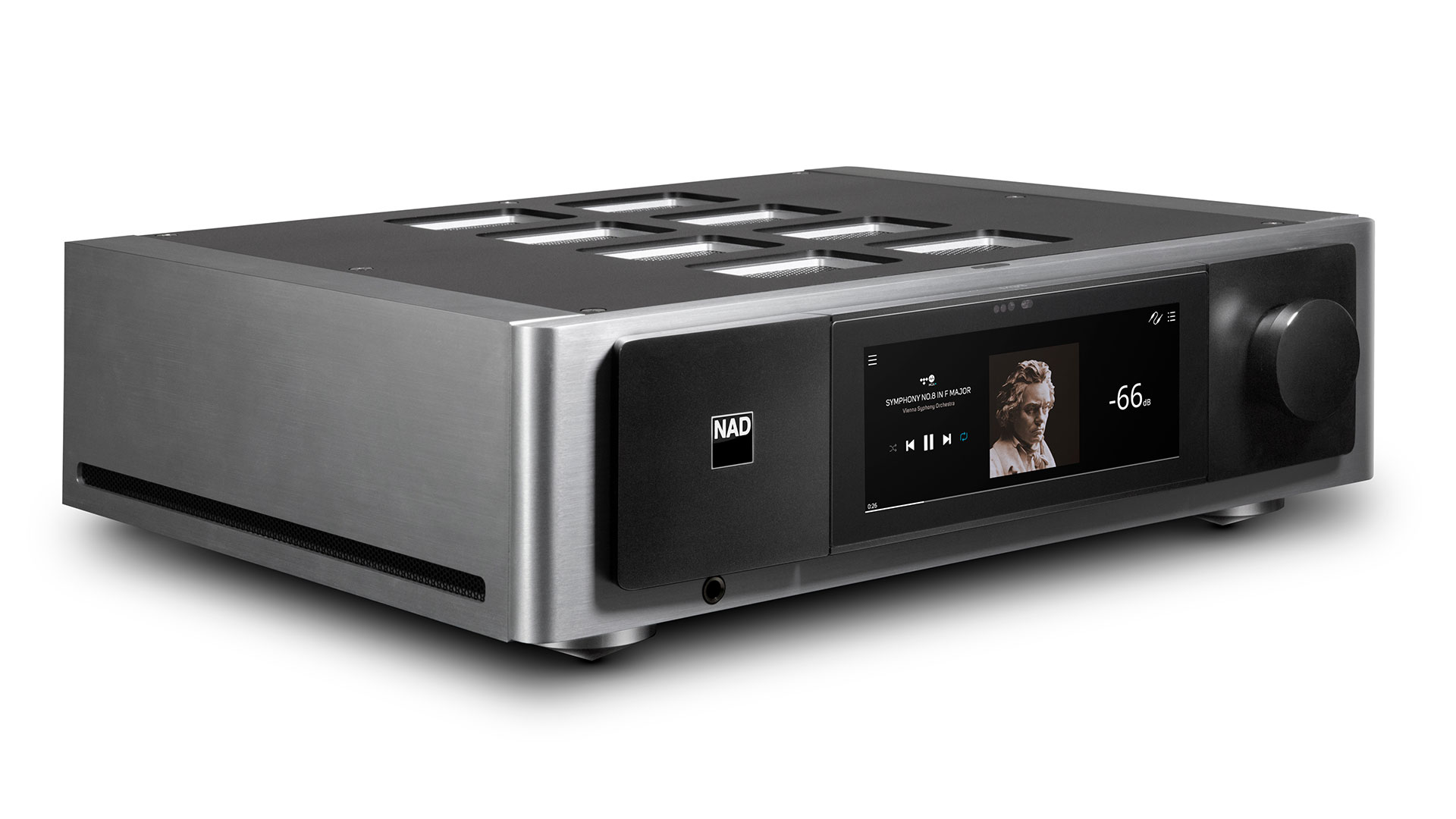
Inputs: mm/mc phono, 1 x line-level RCA, 1 x balanced XLR, 2 x optical, 2 x coaxial, 1 x AES/EBU, 1 x USB-A, HDMI ARC, Wi-Fi, Ethernet, BluOS, AirPlay 2, Bluetooth with aptX HD, RS232, IR in, trigger in
Outputs: 2 x sub out, preout, 2 x speakers out, headphone out, IR out, trigger out
Quoted power: 200W into 4/8 ohms
Dimensions: 435 x 133 x 396mm
The physical ‘HTRM 2’ remote control provided is a delightfully weighty button-laden wand which illuminates at night when you press something, but not during the day because it has a light sensor — neat! Powered by four AA batteries, it’s far more than just a remote for the M33 — it is designed to control up to eight devices, whether a whole NAD system for which you can load code libraries for the models you have, or by manual learning to control pretty much anything.
Pressing the relevant device key (e.g. BD) switches all the remote’s keys to that product’s IR codes. Highly versatile if that’s what you want to do, although otherwise a lot of it turns out to be entirely irrelevant to the M33 alone. The ‘Disp’ button, for example, doesn’t usefully dim the M33 display but instead offers options for controlling the back illumination of the remote itself! And the input section buttons are all labelled simply 1 to 10, so you’re constantly taking a punt on finding what you want, at least until you’re acclimatised.
Its menu and channel buttons seemed to have no effect on the amp. And there’s no easy information button to show file quality on the display (although you can hunt that down in the BluOS app, or set the display style to show detailed information). Indeed for the M33 alone, a smaller remote might be rather more convenient — power, volume, play/pause and a control circle perhaps.
The HTRM 2 remote is an undeniably high-end remote, but not the most convenient. The BluOS app, however, gives far more — and far easier — control over everything from input selection to streaming services and player preferences, including small but important things such as setting auto-turn-off and brightness for the display.
There’s also a good light-saving ‘dark mode’. You can also easily use the touchscreen on the front panel directly, and access all the settings from there, displayed neatly and responsively. Indeed some settings are only available there — switching the phono input to moving-coil, for example, and gain-matching to equalise the level of the analogue inputs. Here you can also choose whether the display shows the digital VU meters, track information, or just blanks out quickly once you’ve made a selection.
We plugged in a USB drive of high-res files and also connected BluOS to a NAS drive — this latter process requiring manual entry of the path, a bit of trial and error involved (the app finally accepted a combination of iP address and top-level folder, ‘\\192.168.1.18\Public’ as an acceptable path).
BluOS indexes the songs before displaying them along with artwork in one of app-dom’s best organised presentations. Sadly there’s no longer a way to index an iTunes/Music collection on a Mac; instead you can just play on the Mac itself and then AirPlay the tunes to the M33. This worked with both our Macbook Pro and iPad Pro, though an older Mac Mini refused to connect this way.
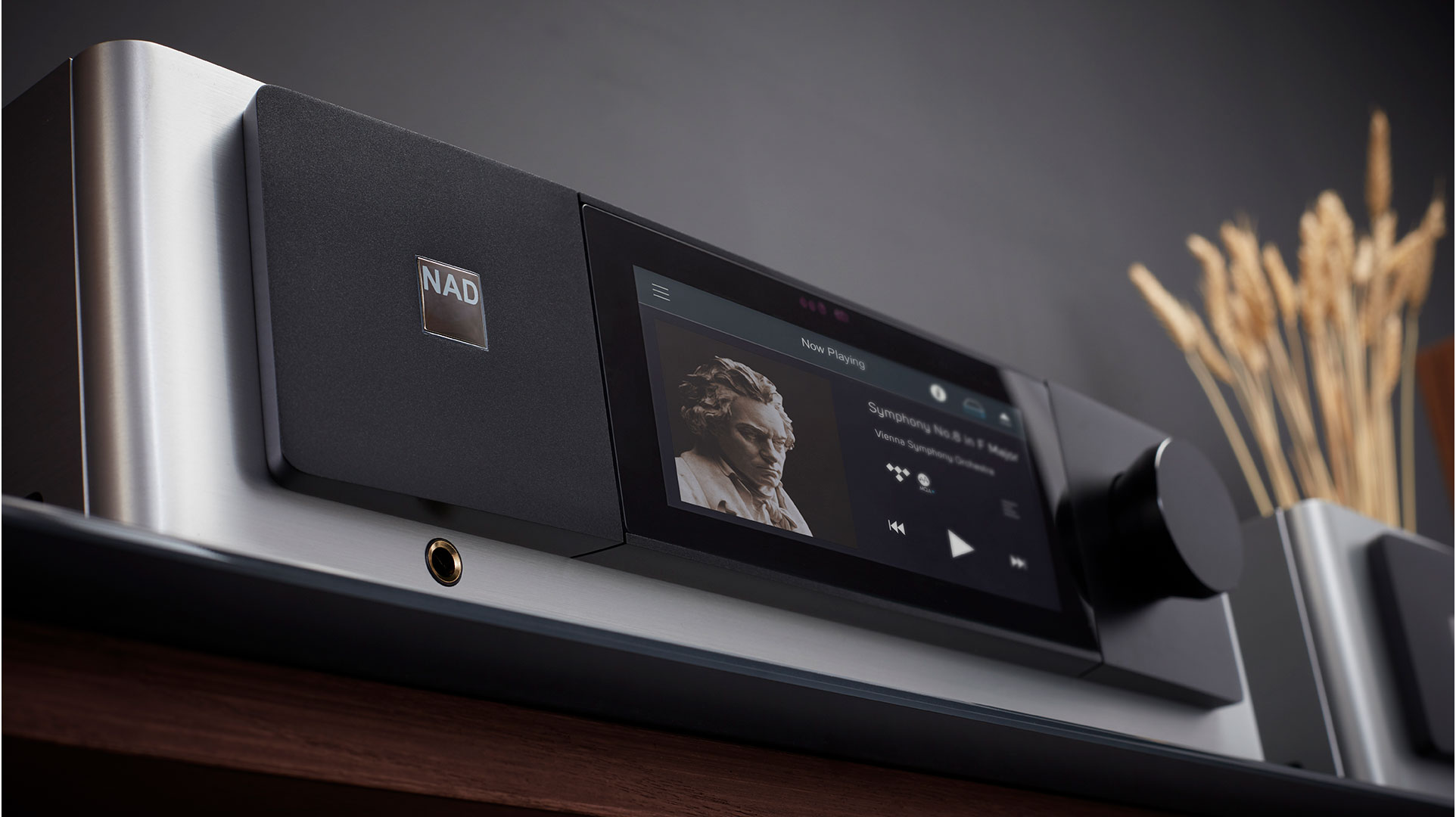
Sound
So much tech to wade through before we can just sit back and enjoy the quality of amplification on offer here! And this is where all the tech and the buttons and the app recede in the shadow of the music, as the M33’s PuriFi power took full control of our speakers and — over an utterly silent backdrop — delivered album after album of perfectly-honed music.
From the attached USB drive of high-res files we belted out ’Deed I Do from a probably unnecessarily high-res version of the 1963 ‘Ella & Basie’ album and — kapow! — the sheer dynamics of Basie’s big band brassily accentuated every phrase of Ella’s liquid central vocal with such intricate immediacy that it made us divert to some more ping-pong stereo mixes, hearing the way each instrument inhabits its physical space in the allocated speaker while pushing the music out as a whole.
BluOS is fully capable of MQA decoding so we played Van Morrison’s Moondance, an MQA encoding at 24-bit/48kHz but unfolding to 192kHz through the M33; it’s a slightly mild presentation but the quality allowed us to turn it up to full lifesize playback, at which level it shone.
But the M33 was not only high-res capable; our CD-res rip of kd lang’s Outside Myself emerged huge and full, its immaculate vocal rolling in cream, the guitars scintillatingly zingy, and the climaxes on the choruses delivered with no compression of sound despite the spread of harmonies, the stick hits unobscured behind that, all the detail and expansiveness simply lusciously rolling forth.

Vinyl playback
The earthing post on the M33 was, strangely, too far from the phono input for our turntable cables to reach, and our Thorens hummed away until we jammed the loose spade into one of the RS232 input’s fastening screws, which silenced it nicely. It thereafter proved itself superior to our usual Musical Fidelity phono amp, its internal phono stage passing rich and real analogue tones, pleasingly full in the bass.
The stereo mix of Can’t Buy Me Love on a near-immaculate Australian pressing of the ‘Hey Jude’ compilation was rare in its revelation and beautifully clear. Moving on to more ping-pong music with I Should Have Known Better, John’s vocals doubled-up in the centre, bright and crisp in their reverb doses, with Paul’s bass, Ringo’s drums and John’s rhythm guitar left, George’s lead and harmonica right.
So free of audible distortion was this presentation that we upped the volume dial to -10dB without a thought of calming down, and on we played to the end of side two, where the scream opening the last track Revolution was blood-curdlingly primal, the right-channel guitar thrillingly dirty, Ringo thumping away in the left, with fine cut-through to his snare. Another ping-pong classic.
We noted a small delay on the phono input as we dropped and lifted the needle; the product of processing, presumably, and also indicating that this input is digitised for the purpose of applying digital RIAA de-emphasis and whatever other phono processing is available. Indeed all analogue inputs are digitised, and there’s an option accessible (only from the front panel) to choose the sample rate at which this is performed; the default of 48kHz perhaps indicates NAD’s view of excessive sample rates, as does the fact that playback via any method tops out at 24-bit /192kHz, with no support for DSD at all (other than NAD suggesting you convert such files to PCM for playback).
As noted, digitising our vinyl in this way (we cranked the rate to 192kHz, just ’cos we could) had no apparently deleterious effects on the music, possibly even enhancing clarity by the digital processing removing the phase changes of analogue circuitry, while the slight time lag would delay the effect of any acoustic feedback — we were playing mighty loud (and the Thorens turntable cover can’t be used during playback).
We closed our vinyl session with one of four 12-inch Frankie Goes To Hollywood discs taken from a 2018 Record Store Day box-set, and the megadrive of Welcome To The Pleasure Dome was a clean, dynamic and mega-massive sonic feast from start to finish, playing undistorted yet so loud that we confess to shouting along quite a lot, though we could barely hear ourselves doing so. (The neighbours complimented our musical choices the next day, understanding folk that they are.) There’s no tonal overlay here: the NAD pulled everything the Thorens is capable of delivering and sent it forth at full charge; we’re sure it would do more with even higher-level decks, though we can’t imagine the pleasure factor being any higher than it was for us during this session.

Digital playback
We used TuneIn for internet radio, and enjoyed thrilling Tidal playback, which can include MQA high-res files if you stump up for Tidal’s HIFI-level tier. We also used the M33 to drive a variety of speakers: from teeny Quads to unfriendly German standmounts to our reference giant JBLs, and never once did we hear anything but complete authority from the M33.
Any quirks? We listened intently to one high-res track we didn’t recognise, part of a playlist we’d set up in BluOS from files on our attached USB drive — deep and sonorous it was, and we eventually recognised it as Jan Gunner Hoff’s piano piece Living — but playing at half speed. It’s 24-bit/352kHz FLAC file from 2L, beyond the M33’s abilities. (When we returned to it later, it played silently.) So be aware that files of higher-res than 192kHz may either not play at all or may play with strange results. DSD files simply don’t show up.
Despite having no USB-B input to play from computer, our resident Musical Fidelity USB DAC could provide it with both an optical input and and analogue line in, so we could compare the NAD’s DAC with our own. The NAD rather showed up our reference by considerably improving on the clarity of the massive soundstage provided to Sufjan Steven’s extravagantly-titled They Are Night Zombies!! They Are Neighbors!! They Have Come Back From the Dead!! Ahhhh!, a busy mix which the M33 split apart into its individual elements and re-combined into a powerfully congruent whole.
Reading the USB-attached drive had a few problems. First day, everything great; wonderful high-res playback. Second day (after a BluOS update) it could see all the folders on the drive, but none of the files.
Nothing, including re-insertion and a full factory reset (painful, as everything has to be reindexed afterwards) brought them back. Issues with our drive or NAD’s logic? Impossible to say. Later we used a simple USB stick with around 20 test files on it, and had no similar issues.

Dirac Live
One thing NAD can’t control is the rooms into which its products will go, or the loudspeakers with which they will be partnered. To that end the M33 comes with a microphone and Dirac Live room correction on-board, one of the most respected room correction solutions on the market, aiming to measure and correct the acoustic characteristics of both your loudspeakers and your room. Or at least it does so for bass, since it operates only from 20Hz up to 500Hz; for higher frequencies you’d have to upgrade to Dirac Live Full Frequency.
Dirac Live used to require loading on a computer; thankfully there’s now an app for that. We were bemused to see that NAD says it “supports NAD RoomFeel EQ target curve” — RoomFeel was developed by Paul Barton of NAD’s sister company PSB Speakers, and the technology was specifically designed for headphones, to compensate for the lacking warmth of room reflections; indeed it is one of the things that makes PSB’s M4U 2 and 8 such superb-sounding headphones.
Presumably that response was designed to create the ideal room response, and so doubles nicely as the target for Dirac Live. If you have a difficult room — unusual shape, nasty surfaces you can’t fix — room correction can be enormously effective, and Dirac is one of the most sophisticated systems available, even in this up-to-500Hz version. It returned a near-flat result for our listening room, and made so little difference that we didn’t leave it on.
Purifi Audio ‘Eigentakt’
As noted, NAD has an impressive record of working with new and innovative amplification technologies in its Masters Series products (and trickling down to its other ranges).
And for the M33 the company has turned to the latest amplification technology in town, which purports to take Class-D concepts to new levels, with negligible distortion, extraordinarily low noise, load-invariant frequency response, exceptionally clean clipping, low losses and high efficiency, while delivering 400W of power without even getting hot. It comes from Purifi, in Denmark, which has named the technology ‘Eigentakt’, which is German for ‘self-clocking’.
We’d exercise our usual caution with such remarkable claims, but what makes us more inclined towards credence in this case is, besides NAD’s rush to adopt it, the team that’s behind it. The three listed co-founders of Purifi Audio are Bruno Putzeys, Lars Risbo and Peter Lyngdorf — and that’s a very illustrious trio indeed!

Bruno Putzeys is a Belgian engineer who spent a decade at Philips working on switching amplifier technologies before striking out on his own with Hypex, also as a collaborator in Grimm and later as CTO with Kii Audio. NAD’s adoption of Hypex’s Universal Class-D amplification and Ncore revolutionised its amplifier range a decade ago, and for the last few years Ncore has been the go-to audiophile Class-D module for many audiophile brands.
Putzeys seems an entertaining individual beyond his audio prowess: his personal website describes his professional activities as “including most things audio, analogue hardware in particular. My first hobby is trying to be relaxed about being not at all good at my second hobby, which is trying to be zen about failing miserably at the first.”
Lars Risbo, meanwhile, first established his musical credentials as principal cellist of the Copenhagen Youth Symphonic Orchestra, going on to develop ‘equibit’ technology in his Danish company Toccata Technology, as used in the highly-regarded TacT Millennium amp ‘way back in 1999, this early ‘digital amp’ circuit gaining rare audiophile praise.
He was also early in more carefully defining the technology to overcome the general disdain for ‘digital’ amplification, really being a powered DAC in which the signal remains digital all the way through to the point it exits at the speaker terminals, achieved by switching from a PCM bitstream to pulse-width modulation (PWM), although he notes that “the PCM-to-PWM process is the easy part — the power stage was the hard part”, where the PWM is integrated at the output by switching a steady voltage.
Toccata was subsequently purchased by Texas Instruments in 2000, where Risbo started a project called ‘SmartAmp’ and went on to be elected TI Fellow in 2012 and Audio CTO in 2013, now holding more than 30 patent ‘families’. This connection has seen several other TI personnel come to work with Purifi. One of these is the company director Claus Neesgaard, who developed several core innovations in Class-D amplification for Toccata and went on to head TI’s Audio DSP product line, leading the transition into streaming-based system solutions.
Also involved in the TacT amplifier was hi-fi luminary Peter Lyngdorf — also now a co-founder of Purifi. Lyngdorf brings his connections to the likes of DALI, Steinway Lyngdorf and the Hi Fi Klubben retail network, as well as a close relationship with NAD dating back almost to its earliest days.
Put these Purifi co-founders together and you have a team able to develop switching amplification at its highest level, to bring it to market, and to enjoy themselves in the process. The resulting Eigentakt module is small given its stated output of 400W, although it is notable that NAD rates the M33 at 200W continuous, perhaps because the distortion characteristics of the module rise dramatically above 150W into eight ohms, reaching 1% THD+N, whereas below that the figures are astonishingly low: 0.00017% at 100W into eight ohms across the full audio spectrum, and output noise of just ~11.5μV A-weighted. Putzeys says the module has the frequency and phase response of a second-order Butterworth filter cornering at 60kHz, so very nearly ‘linear phase’ in the audio band. The quoted dynamic range for the module is 131dB, and its efficiency as greater than 94%. So chunky heatsinks not required!
The secret of Eigentakt
Eigentakt’s secret, says Purifi, is the application of nonlinear control theory, which it used to develop a “mathematically exact” optimisation of the feedback circuit that improves performance by at least an order of magnitude over existing implementations.
The result is a large-signal self-oscillating amplifier which is extremely stable, has an output impedance below 65μΩ at 1kHz, and makes the impedance curve of the speaker irrelevant (subject, we gather, to a lower limit). There’s also an immunity to noise from even simple switched-mode power supplies, as well as a comprehensive protection system which makes it robust in operation and particularly easy to integrate into complete amplifier designs.
There’s one particular development highlighted by Putzeys and Risbo that is best explained in a Q&A with the pair published by audiophilestyle.com, where Putzeys explains: “The only real surprise we had recently was to do with the output choke. Magnetic materials have something called hysteresis, but there is precious little information about what this really does. If you test a magnetic core with a sine wave, the distortion looks a little like soft clipping, perfectly benign. But what came out of tests on iron parts in loudspeakers was that hysteresis has a long-term memory, so you can get intermodulation between things that happen now and things that happened 10 minutes ago. With music, this distortion sounds like half-correlated noise.”
“Crackling,” interjects Risbo. “You hear when each magnetic domain flips.”
“When you put the coil inside the amplifier’s feedback loop, that distortion gets reduced along with the distortion of the power stage and everything else,” continues Putzeys. “We have a strong suspicion here that the most audible distortion in typical Class-D amplifiers may very well be that.”
In the Eigentakt circuit, he says, the extreme amount of loop gain (about 75dB all the way to 20kHz, 20dB better than any of Putzeys’ previous designs) reduces the sonic footprint of the output choke.
Perhaps surprisingly, Purifi’s other new product is a 6.5-inch woofer from its transducer subsidiary co-owned by Carsten Tinggaard, formerly an engineer with Peerless, and most recently with R&D and measurement consultancy PointSource. The new woofer leverages the same reduction in magnetic hysteresis distortion in the goal to deliver a small long-throw driver which delivers the greater linearity of a larger short-throw driver.
Purifi identified the problem of Force Factor Modulation, which comes as a “side order” of magnetic hysteresis distortion. While iron-free drivers overcome this, they are an expensive option. Purifi’s new motor claims to be virtually free from FFM, while a new surround design addresses the issue of the cone surface area changing as excursion increases.
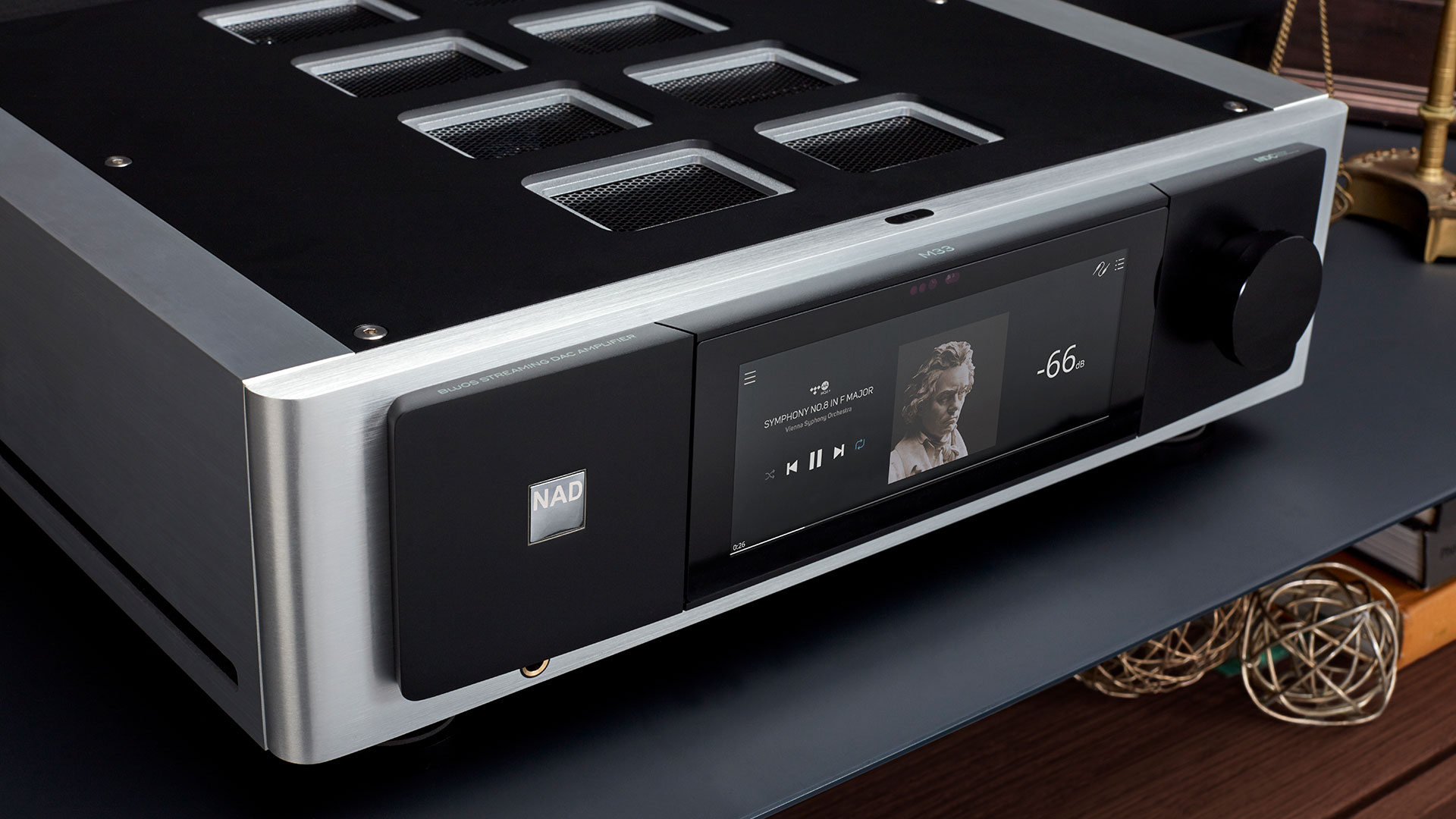
Verdict
But we digress. NAD’s M33 BluOS Streaming DAC Integrated Amplifier is a rip-roaring success in all important regards, and innovates in several key areas. It continues to evolve the close integration of one of the leading streaming and multiroom technologies, the high-res capable BluOS, with a powerful hi-fi amplifier of high quality.
And it sees NAD continuing to leverage the most impressive of new amplification technologies to push its Masters Series of products to new heights of power and musicality. Impeccable build, great looks, a good range of inputs, that giant and friendly touchscreen and a high-end remote — it ticks all the boxes.
But when it comes down to it, it’s the music that is the most impressive of all, delivered at a level that confirms NAD’s reputation for picking and perfecting new amplifier technologies so that its reputation for high-value student systems is being well and truly left behind for something even more capable, grander, and more musically moving.
Sound+Image is Australia's no.1 mag for audio & AV – sister magazine to Australian Hi-Fi and to the UK's What Hi-Fi?, and bestower of the annual Sound+Image Awards, which since 1989 have recognised the year's best hi-fi and home cinema products and installations. While Sound+Image lives here online as part of our group, our true nature is best revealed in the print magazines and digital issues, which curate unique collections of content each issue under the Editorship of Jez Ford, in a celebration of the joys that real hi-fi and high-quality AV can bring. Enjoy essential reviews of the most exciting new gear, features on Australia's best home cinemas, advice on how to find your sound, and our full Buying Guide based on all our current and past award-winners, all wrapped up with the latest news and editorial ponderings. Click here for more information about Sound+Image, including links to buy individual digital editions and details on how best to subscribe.
